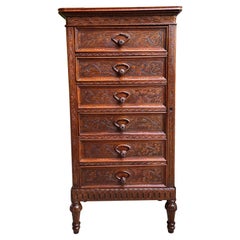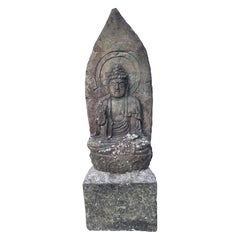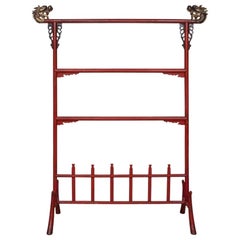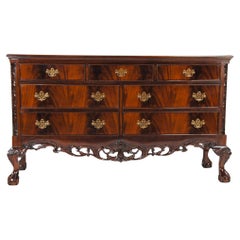Hand-Carved Furniture
to
4,108
14,852
11,553
23,527
6,853
469
1,873
1,657
1,143
936
935
931
845
798
652
618
592
486
434
372
366
258
140
22
4,486
9,154
9,887
7,322
3,376
3,571
1,427
380
124
338
268
245
476
453
494
237
92
21,827
8,244
7,010
4,601
3,069
19,084
6,111
5,195
5,116
3,424
30,849
25,814
27,074
1,459
372
293
218
210
Technique: Hand-Carved
Antique English Victorian Wellington Chest of Drawers Campaign Carved Oak
Located in Shreveport, LA
Antique English Victorian Wellington Chest of Drawers Campaign Carved Oak.
Direct from England, a stunning antique English “Wellington Chest”, one of the first we have found in quit...
Category
Late 19th Century British Victorian Antique Hand-Carved Furniture
Materials
Oak
19th Century Painted French 5 Drawer Chest
Located in Houston, TX
Painted French 5 Drawer Chest with Swedish style distressed finish
Category
19th Century French Country Antique Hand-Carved Furniture
Materials
Wood, Paint
Japanese Tall Antique Stone Buddha Shakyamuni 27 Inches And Signed
Located in South Burlington, VT
A very old Taisho period early 20th century granite stone Buddha - Shyaka Nyorai Sakyamuni- sculpture perched upon a square base.
Signed front left with named patron: hidaka shig...
Category
Early 20th Century Japanese Taisho Hand-Carved Furniture
Materials
Stone, Granite
$2,240 Sale Price / set
20% Off
19th Century Swedish antique rustic Country Chest of drawers with original paint
Located in Boden, SE
19th Century Swedish Gustavian chest of drawers from Piteå, Norrbotten , Northern Sweden. The chest of drawers is a Swedish country house furniture from between 1820 and 1840. Made i...
Category
Early 19th Century Swedish Gustavian Antique Hand-Carved Furniture
Materials
Pine
Fine Older Chinese Robe Rack in Cinnabar Paint
Located in Bridgeport, CT
A fine vintage robe rack with generous proportions having a good traditional form. There are two carved dragon head top elements that are powerfully carved, ...
Category
20th Century Chinese Ming Hand-Carved Furniture
Materials
Wood
Chippendale Mahogany Triple Dresser
Located in Annville, PA
The Chippendale Mahogany Triple Dresser. A classic furniture shape this chest features three drawers across the top section and two rows of two...
Category
2010s Chippendale Hand-Carved Furniture
Materials
Mahogany
$4,100 / item
19th Century Intricately Carved Anglo-Indian Side Table
Located in North Hollywood, CA
Antique 19th Century Intricately Carved Anglo-Indian Side Table.
A beautiful finely carved British Colonial wooden occasional side table from India.
Antique fine quality pierced an...
Category
Late 19th Century Indian Anglo-Indian Antique Hand-Carved Furniture
Materials
Wood
Sunburst Carved Golden Mirror
Located in LA CELLERA DE TER, ES
Vintage handcrafted golden sunburst mirror. Composed of a unique level of twenty curved gilded wooden rays.
Dimensions: 30,32 in/77cm diameter
Mirror dimensions: 7,90 in/20cm diameter
Category
21st Century and Contemporary Spanish Modern Hand-Carved Furniture
Materials
Gold Leaf
Carved and Painted Wooden Horse
Located in Bochum, NRW
A charming vintage hand carved wooden black horse, richly decorated and enhanced with gold accents.
Used condition, some cracks and fading to the paint, otherwise good.
Dimensions:...
Category
20th Century European Hand-Carved Furniture
Materials
Wood
$881 Sale Price
25% Off
A French wooden neo-Gothic steeple with niche for saint statue, ca. 1800
Located in Meulebeke, BE
France / 1800 / Neo-Gothic steeple with niche for saint statue / wood / Neo-Gothic / 19t century
A very rare and large antique Neo-Gothic church steeple with niche for saint statue....
Category
Early 1800s French Gothic Revival Antique Hand-Carved Furniture
Materials
Wood
Massive Gustavian Trestle Base Dining Table
Located in Baton Rouge, LA
This massive Swedish Gustavian pine dining table is over 12 feet long, (12’-3 ⅝” to be exact). The simple wooden top sits over a pair of hand-cut and painted trestle base legs, each ...
Category
19th Century Swedish Gustavian Antique Hand-Carved Furniture
Materials
Iron
Chippendale Nostell Priory Mirror
Located in Sturminster Marshall, Dorset
This exceptional mirror is carved in the Chinese taste, surmounted with a pagoda and carved HoHo bird with foliate plate divisions and pierced fretwork apron. The original mirrors were after those created by the cabinet-maker Thomas Chippendale (d. 1779) for the State Bedchamber, Nostell Priory...
Category
2010s English Chippendale Hand-Carved Furniture
Materials
Mahogany
Antique French 18th Century Gothic Style Oak Carved High Back Panel Settle
Located in Meulebeke, BE
France / 1850 / settle / oak / Gothic / Antique / Mid-century
A highly decorative hand carved oak settle crafted around 1850 in France. Nicely detailed carved and open worked panell...
Category
18th Century French Gothic Antique Hand-Carved Furniture
Materials
Oak
French 19th Century Empire Gueridon
Located in Baton Rouge, LA
A large French Empire period gueridon from the 1800’s. The original fossil black marble top has been professionally repaired. Its refined mahogany base has a simple apron above a col...
Category
19th Century French Empire Antique Hand-Carved Furniture
Materials
Marble, Brass
George IV Walnut & Burl Walnut Two-drawer Console Table
Located in San Francisco, CA
the handsome and richly-patinated English table in the Neo-Gothic taste with long rectangular top within a half-bullnose molding; above a frieze apron fitted with two drawers; raised...
Category
1830s English George IV Antique Hand-Carved Furniture
Materials
Walnut
Italian 18th Century Carved Gilt Mirror Frame With 19th Century Glass
Located in Houston, TX
This lovely Mirror Frames is from the 1700s Italy and replaced 19th century mirror is so charming. It has a few missing pieces but not anything that takes away from its beauty. In f...
Category
Late 17th Century Italian Antique Hand-Carved Furniture
Materials
Gold Leaf
Country French Carved Oak Ladder Back Chairs with Rush Seat, Set of Six
Located in Dallas, TX
These six elegant country chairs were crafted in Normandy France, circa 2000. Carved from solid oak, each chair stands on turned front legs and back legs, all connected with a bottom...
Category
Early 2000s French Country Hand-Carved Furniture
Materials
Rush, Oak
19th Century Catalan Spanish Carved Walnut Console Sofa Table, Three Drawers
Located in Miami, FL
19th century Spanish antique walnut chest of four drawers and original iron hardware.
You can use like a commode or chest of drawers
This elegant console was crafted in Spain, circa ...
Category
Late 19th Century Spanish Baroque Revival Antique Hand-Carved Furniture
Materials
Iron
Dry bar luxury Murano glass made in Italy Justfurnituress Design
Located in Guazzora, IT
Dry bar luxury in handcrafted Murano glass made in Italy Justfurnituress Design
Discover the exceptional Murano glass bar cabinet, a unique piece crafted by JustFurnituress that com...
Category
21st Century and Contemporary Italian Mid-Century Modern Hand-Carved Furniture
Materials
Brass
60 inch Round Dining Table
Located in Annville, PA
The 60 inch Round Dining Table is produced with a figured mahogany field and satinwood banding on the top which makes for an interesting con...
Category
2010s Hand-Carved Furniture
Materials
Mahogany
$6,390 / item
Rustic Hand Carved Stone Garden Coffee Farm Patio Table Outdoor Indoor Antique
Located in West Hollywood, CA
Rustic hand carved stone Garden coffee Farm patio table outdoor indoor Antique. 18th 19th Century hand carved stone antique elements garden low coffee Farm table on a simple single carved stone base pedestal.
It will be the perfect touch by an outdoor fireplace, This table has a lot of charm and character.
It can work in a Mid-Century Modern or an old charm rustic Provençal design or a Farmhouse. For an interior or exterior handsome design, for garden landscaping it's a beautiful architectural element to complement your garden furniture or the interior of living room Antique...
Category
Late 18th Century French Antique Hand-Carved Furniture
Materials
Stone, Limestone
$10,960 Sale Price
20% Off
19th Century Swedish antique rustic Country Gustavian table
Located in Boden, SE
Early 19th Century Swedish antique Rustic Gustavian Provincial table from Skellefteå Västerbotten,Northern Sweden.
The table is scraped by hand to its original paint.
The table is ea...
Category
Early 19th Century Swedish Gustavian Antique Hand-Carved Furniture
Materials
Pine
1950s German Alpine Pendant Light Carved Painted Wood Climber with Lantern
Located in Barntrup, DE
Charming 1950s German Alpine Pendant Light with Carved and Painted Wooden Climber
This delightful German figural pendant light from the 1950s fe...
Category
1950s German Black Forest Vintage Hand-Carved Furniture
Materials
Metal
Still Stand Abstract Biomorphic Wood Sculpture, Column, Chainsaw Carved, XL
By Logniture
Located in Stara Gradiška, HR
This exquisite black sculpture, made from reclaimed charred oak beams, embodies a blend of artistry and sustainability. Its design features a captivating arrangement of rounded forms...
Category
21st Century and Contemporary Croatian Brutalist Hand-Carved Furniture
Materials
Oak
Elegant French Vintage Fireplace Surround in Limestone
Located in Beervelde, BE
Elegant French Vintage Fireplace surround.
Small fireplace surround in a timeless beige limestone from the Louis Philippe period, 19th cent...
Category
19th Century French Louis Philippe Antique Hand-Carved Furniture
Materials
Limestone
Bédoin Carved Limestone Wall Fountain from Provence, France
Located in Dallas, TX
This elegant and large wall fountain is from the Provence region of France. Comprised of 17 pieces of hand-carved Estaillade limestone, the fountain has a lovely cream patina with wh...
Category
21st Century and Contemporary French Hand-Carved Furniture
Materials
Stone, Limestone, Metal, Iron
Antique French Petite Bookcase Server Barley Twist Louis XIII Carved Oak c1890
Located in Shreveport, LA
Antique French carved oak petite bookcase server barley twist display louis XIII
~Direct from France~
Very special petite size 19th century French Lou...
Category
19th Century French Louis XIII Antique Hand-Carved Furniture
Materials
Oak
Empire Mahogany Desk Chair, Early 19th Century
Located in Spencertown, NY
The desk chair with carved diamond motif on crest and richly carved griffin wings above articulated paw feet with tan colored leather upholstery. Height: 30" Seat height: 17" Depth: ...
Category
Early 19th Century French Empire Antique Hand-Carved Furniture
Materials
Leather, Mahogany
Madonna Carved Wood Sculpture Gold Leaf and Polychrome, Spain, Mid-18th Century
Located in Frankfurt am Main, DE
A wood sculpture wonderfully carved depiction of the Virgin Mary with Jesus Child gilded with gold leaf and polychrome painted, Spain, mid-18th century...
Category
Mid-18th Century Spanish Antique Hand-Carved Furniture
Materials
Gold Leaf
$5,167 Sale Price
30% Off
Roger Francois ( Haitian, 1928-2013) Wood Figural Sculpture
Located in Bridgeport, CT
A tall and arresting Hand-Carved wood Sculpture of of an inverted woman. Strongly carved with only acceptable age-related wear including some stable checking to the wood. Signed on b...
Category
20th Century Haitian Tribal Hand-Carved Furniture
Materials
Wood
Gandharan Stucco Head of the Buddha, 3rd-5th Century
Located in Austin, TX
A sublime Greco-Buddhist stucco head of the Buddha, ancient region of Gandhara, circa 3rd-5th century.
A fragment of a larger statue, the Buddha's face...
Category
15th Century and Earlier Pakistani Antique Hand-Carved Furniture
Materials
Stucco
Early 20th Century burr yew desktop box with clock
Located in Debenham, Suffolk
Early 20th century burr yew desktop box with clock circa 1920.
Empire revival burr yew cigar box with clock. Strung and inlaid to outer edges, decorated with an ormolu mount to the lid and standing on ormolu bun feet. Inset white enamel clock face...
Category
Early 20th Century Swedish Empire Revival Hand-Carved Furniture
Materials
Yew
21st Century Italian Contemporary Minimalist Circular Marble Side Table
Located in West Palm Beach, FL
An Italian, contemporary minimalist circular side table with a conical shaped base and a 1.75” thick round top in hand carved white polished marble, inspired by the Italian furniture...
Category
21st Century and Contemporary Italian Mid-Century Modern Hand-Carved Furniture
Materials
Marble
Spectacular Green Console with Murano Mirror Glass, Three Drawers and Brass Legs
Located in Guazzora, IT
This spectacular green console table is an extraordinary piece of furniture that combines mid-century modern aesthetics with exceptional craftsmanship.
Handcrafted in Italy, it fea...
Category
21st Century and Contemporary Italian Mid-Century Modern Hand-Carved Furniture
Materials
Brass
$4,255 Sale Price
20% Off
Large early 20th century globe on stand by jordglob
Located in Debenham, Suffolk
Large early 20th century globe on stand by jordglob circa 1909.
Beautiful Swedish globe of generous proportions. A 1909 globe in good condition suspended on a brass arm, which sits...
Category
Early 20th Century Swedish Edwardian Hand-Carved Furniture
Materials
Metal
Alabaster Baluster Form 19th Century Table Lamp, Hand Carved
Located in Lomita, CA
This alabaster lamp is stunning, with its irregular veining and exquisite carving. It is antique Regency style hand carved alabaster from the late 19th Century.
The baluster form is surmounted by a carved drum...
Category
Late 19th Century English Regency Revival Antique Hand-Carved Furniture
Materials
Alabaster
$719 Sale Price
20% Off
18th Century, Italian Neoclassical Demi-lune Wood Console by Francesco Bolgiè
By Francesco Bolgié
Located in IT
18th Century, Italian Neoclassical Demi-lune Wood Console attributed to Francesco Bolgiè
This fine and refined neoclassical console was built in the neoclassical era in Turin, Italy,...
Category
Late 18th Century Italian Neoclassical Antique Hand-Carved Furniture
Materials
Marble
Hand-Carved Malachite Decorative Box
Located in New York, NY
Crafted from solid, natural Malachite, this one-of-a-kind hand-carved decorative box is a singular work of art featuring the stone’s signature swirling green banding, contrasting bul...
Category
2010s Congolese Hand-Carved Furniture
Materials
Malachite
Kalathi Lantern by M.Fisher x Remains Lighting Co.
Located in New York, NY
MHL4520
A hanging lantern with a hand-carved, veined white alabaster 'basket' shade, mounted with brass shields and suspended by slender hooks and a milled canopy. Each hook is wrapp...
Category
2010s American Hand-Carved Furniture
Materials
Alabaster, Brass
$30,000 / item
Procession banner with Maria and Child
Located in 'S-HERTOGENBOSCH, NL
Procession banner from the German pilgrimage site Kevelaar (near the Dutch boarder). The banner, in blue, red and beige silk with brocade, hangs from a wood carved and gilded pendant...
Category
1880s German Gothic Revival Antique Hand-Carved Furniture
Materials
Brocade, Canvas, Silk, Giltwood
18th Century French Marble Mortar
Located in Chicago, IL
An 18th-century French carved marble mortar, rich with history and softened by centuries of use, its surface worn smooth with a patina that only 250 years of culinary tradition could...
Category
18th Century French Rustic Antique Hand-Carved Furniture
Materials
Marble
Carved Polychromed Chinese Horse
Located in Palm Springs, CA
A wonderful 20th century carved painted wooden Chinese horse purchased in 1985 from a prominent Hong Kong Gallery. A copy of the original receipt will be...
Category
20th Century Chinese Hand-Carved Furniture
Materials
Wood
Vintage Italian Multi-Colored Empoli Glass Genie Decanter Bottles with Stopper
By Empoli
Located in Los Angeles, CA
Vintage Italian Multi-Colored Geometric Design Empoli Glass Genie Decanter Bottles with Stoppers, and here is Individual Dimensions:
Net Price for e...
Category
1940s Italian Vintage Hand-Carved Furniture
Materials
Glass, Blown Glass
Authentic Japanese Woodblock Print by Kawase Hasui - Kiyomizu Temple in Kyoto
Located in Norton, MA
Description
Kawase Hasui - Kiyomizu Temple in Kyoto, woodblock, 1933, published by The S. Watanabe Color Print Co., with the 7mm and Heisei seals, 15.25" x 10.25".
This item is in ex...
Category
Mid-20th Century Japanese Hand-Carved Furniture
Materials
Paper
New England Hitchcock Style Chair with Woven Rush Seat
Located in Norton, MA
A New England Hitchcock Style/Fancy chair. Hand painted/stenciled with a deep and rich patination from years of good wear. The seat is woven rush seats and is in very good condition....
Category
19th Century American Antique Hand-Carved Furniture
Materials
Wood
LATE 18th CENTURY SMALL PAINTING WITH A GENRE SCENE
Located in Firenze, FI
A delightful small painting, framed in a contemporary frame in carved and gilded wood, depicting a lively genre scene. In the background, an Italian garden opens up to reveal two you...
Category
Late 18th Century French Antique Hand-Carved Furniture
Materials
Canvas, Wood, Paint
18th Century French Oak Hunt Buffet with Game Bird and Fish Panels
Located in Dallas, TX
From the 1700s, this unusual French hunt buffet has expertly carved paneled doors portraying a game bird and a fish. The game bird is hanging from its feet with knotted ribbons, whil...
Category
18th Century French Renaissance Antique Hand-Carved Furniture
Materials
Oak
Italian 17th Century Oil on Canvas Head of Christ Crowned with Thorns, Mignard
By (circle of) Pierre Mignard
Located in Los Angeles, CA
A very fine Italian 17th century oval oil on canvas "Head of Christ Crowned with Thorns" Circle of Pierre Mignard (French, 1612-1695) within...
Category
17th Century French Baroque Antique Hand-Carved Furniture
Materials
Canvas, Giltwood
$48,950 Sale Price
24% Off
Fine French 19th Century Louis XV Style Carved Walnut Three-Piece Salon Suite
Located in Los Angeles, CA
A fine and large French 19th century Louis XV style carved walnut three-piece salon suite. The high back intricately carved frames with floral and wreath design, comprising of a thre...
Category
Late 19th Century French Louis XV Antique Hand-Carved Furniture
Materials
Fabric, Walnut
$24,950 Sale Price / set
27% Off
18th Century French Provincial Rustic Table
Located in Madrid, ES
Rustic French oak table with turned legs and crossed stretcher from the 18th century. This table has a rectangular top with rounded corners tha...
Category
Late 18th Century European French Provincial Antique Hand-Carved Furniture
Materials
Oak
$2,175 Sale Price
20% Off
Expressive Early Classic Cubist Dan Mask Early 20th Century Liberia, ex Sothebys
Located in Point Richmond, CA
Expressive early classic cubist Dan mask with refined expressive look, narrow open eyes and mouth and fine line scarification marks around outside of face. Created early 20th century by the Dan People...
Category
Early 20th Century Liberian Tribal Hand-Carved Furniture
Materials
Wood
Murano Style Leopard Tortoise Brown and Beige Signed Art Glass Large Vase
Located in North Hollywood, CA
Murano style tortoise brown and black signed art glass large vase.
Stunning masterpiece of studio art glass hand-made with multicolored organic brown, beige and black, motif is not t...
Category
Early 2000s Italian Organic Modern Hand-Carved Furniture
Materials
Art Glass
Hand cast ceramic tall cylinder Bamboo Table Lamp in hand painted green glaze
Located in London, GB
Designed by and made exclusively for Andrew Kornat Designs by one the of most prestigious ceramicists in historical Florence, Italy which is famed for porcelain and ceramic manufactu...
Category
2010s Italian Hollywood Regency Hand-Carved Furniture
Materials
Ceramic
Carved Giltwood Sunburst Mirror, Hollywood Regency, Spain 1940s
Located in Barcelona, ES
One of a Kind Spanish Gold Leaf Gilded Wooden Sunburst Mirror
__________________________________________________________
Finely carved gold leaf gilded sunburst mirror, Spain, 1930s-...
Category
Early 20th Century Spanish Hollywood Regency Hand-Carved Furniture
Materials
Gold Leaf
19th Century American Dough Bowl
Located in Chicago, IL
A wonderful large 19th century American carved wood dough bowl with a wonderful shape, and an old iron repair. At some point in its lifetime, someone added a hanger on the back so it...
Category
19th Century American Primitive Antique Hand-Carved Furniture
Materials
Wood
French Provincial Louis XV Walnut Settee
Located in Middleburg, VA
French Provincial Louis XV Walnut Settee. Made of Circassian Walnut with scrolled arms over eight carved and molded legs with cross stretchers. Recently reupholstered, great proporti...
Category
19th Century French Louis XV Antique Hand-Carved Furniture
Materials
Fabric, Linen, Wood, Walnut
Antique French Art Deco Carved Wood & Marble Console Table & Wall Mirror Set
Located in Hamilton, Ontario
This antique console table and mirror set is unsigned, but presumed to have originated from France and date to approximately 1920 and ...
Category
Early 20th Century French Art Deco Hand-Carved Furniture
Materials
Glass, Softwood
Original Italian Hand Carved Nude Sculpture/ Lamp Signed Umberto Stiaccini
Located in New York City, NY
Hand carved white alabaster sculpture of a nude woman reclining inside a clam shell with three winged putti carrying her
aloft from shell laden waters.
Signed to verso by the Italian...
Category
Early 20th Century Italian Art Deco Hand-Carved Furniture
Materials
Alabaster
Italian 18th Century Neoclassical Silvered Carved Wooden Pedestal
Located in Buisson, FR
Beautiful weathered Neoclassical pedestal with its original silver-leaf gilding.
Great to use as a display for a small collection or just with some candles.
Italy, circa 1780. Weathe...
Category
18th Century Italian Neoclassical Antique Hand-Carved Furniture
Materials
Wood
$797 Sale Price
47% Off
Stoneware Vase, Brown Color, French 1960
Located in Auribeau sur Siagne, FR
Vase in Stoneware, in a brown color. With leaves decor pattern. French Riviera, it has been made in France circa 1960.
Category
1960s French French Provincial Vintage Hand-Carved Furniture
Materials
Sandstone
$255 Sale Price
20% Off
Recently Viewed
View AllMore Ways To Browse
Lane Mid Century Modern
Iris Glass
Ink Scroll
Leather Bear
Holland And Son
King George Furniture
Japanned English Furniture
Italian Silk Fabric
Japanese Fans
Jugendstil Art Glass
Industrial Mid Century Desk
Italian Rational
Le Corbusier Hand
Hand Painted Soldiers
Japanese Silver Leaf
Hermes Objects
Leaf Dish
Italian Carved Wood Panels





